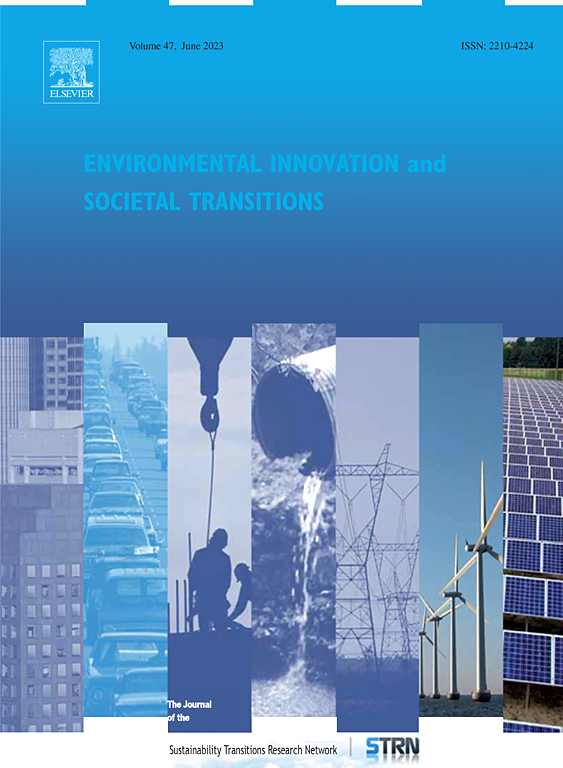Chasing the sun: How does policy-induced local demand promote the spatio-temporal evolution of China’s solar photovoltaic industry
IF 6.1
2区 经济学
Q1 ENVIRONMENTAL SCIENCES
Environmental Innovation and Societal Transitions
Pub Date : 2025-09-05
DOI:10.1016/j.eist.2025.101045
引用次数: 0
Abstract
In evolutionary economic geography, local demand drives industrial evolution by unlocking windows of opportunity for latecomer regional transitions. Focusing on China’s solar photovoltaic (PV) industry’s recovery from post-2012 anti-dumping/countervailing duty (AD/CVD) shocks, this study examines how private (enterprise) and public (government) demand reshape Chinese PV firm dynamic patterns. Using quadrant analysis, bivariate visualization and Poisson regression models, this study finds that regions with strong energy-intensive manufacturing bases and PV-industry chain connectivity attract significantly more firms, demonstrating the critical role of private demand. While enterprise-demand dominated pre-crisis dynamics, government procurement emerges as a key driver post-crisis, particularly reinforcing local self-demand under China’s fiscal decentralization framework. This research contributes to demand-side evolutionary theory by uncovering how institutional mechanisms balance market expansion with local protectionism. These findings offer actionable insights for renewable energy policies, highlighting the need to align public procurement with private demand to foster sustainable industrial transitions.
追逐太阳:政策引导的地方需求如何促进中国太阳能光伏产业的时空演变
在演化经济地理学中,本地需求通过打开后发区域转型的机会窗口来推动产业演化。本研究着眼于2012年后中国太阳能光伏产业从反倾销/反补贴(AD/CVD)冲击中复苏的过程,探讨了私营(企业)和公共(政府)需求如何重塑中国光伏企业的动态模式。利用象限分析、二元可视化和泊松回归模型,研究发现能源密集型制造业基础强、光伏产业链连通性强的地区对企业的吸引力显著增加,证明了私人需求的关键作用。虽然企业需求主导了危机前的动态,但政府采购成为危机后的关键驱动因素,特别是在中国财政分权框架下加强了地方自我需求。该研究通过揭示制度机制如何平衡市场扩张与地方保护主义,为需求侧进化理论做出了贡献。这些研究结果为可再生能源政策提供了可行的见解,强调了将公共采购与私人需求相结合以促进可持续产业转型的必要性。
本文章由计算机程序翻译,如有差异,请以英文原文为准。
求助全文
约1分钟内获得全文
求助全文
来源期刊

Environmental Innovation and Societal Transitions
Energy-Renewable Energy, Sustainability and the Environment
CiteScore
13.60
自引率
19.40%
发文量
90
审稿时长
56 days
期刊介绍:
Environmental Innovation and Societal Transitions serves as a platform for reporting studies on innovations and socio-economic transitions aimed at fostering an environmentally sustainable economy, thereby addressing structural resource scarcity and environmental challenges, particularly those associated with fossil energy use and climate change. The journal focuses on various forms of innovation, including technological, organizational, economic, institutional, and political, as well as economy-wide and sectoral changes in areas such as energy, transport, agriculture, and water management. It endeavors to tackle complex questions concerning social, economic, behavioral-psychological, and political barriers and opportunities, along with their intricate interactions. With a multidisciplinary approach and methodological openness, the journal welcomes contributions from a wide array of disciplines within the social, environmental, and innovation sciences.
 求助内容:
求助内容: 应助结果提醒方式:
应助结果提醒方式:


